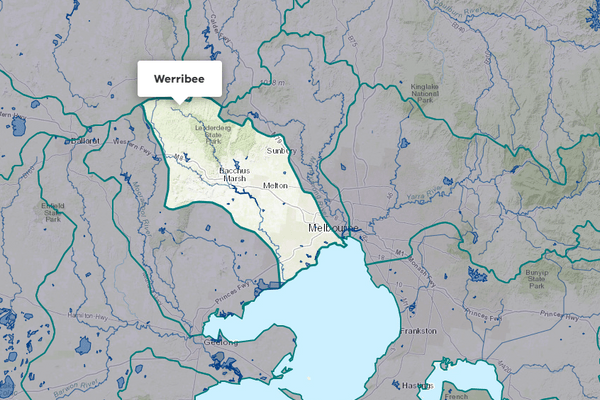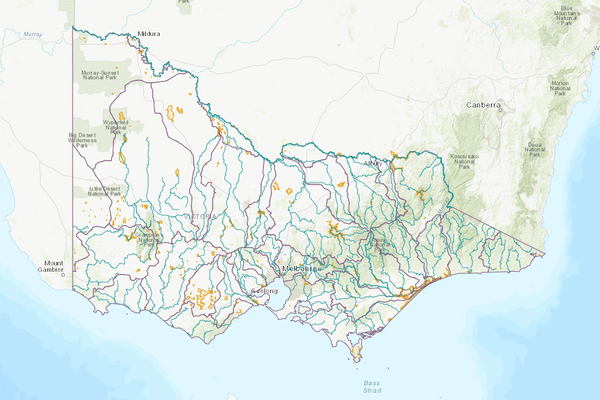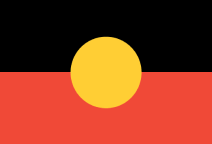About the area
The Maribyrnong River flows from the foothills of the Great Dividing Range in central Victoria towards the south through Melbourne's north-western suburbs, joining the Yarra River before flowing into Port Phillip Bay. Major tributaries include Jacksons Creek and Deep Creek.
Annual rainfall in the basin varies from almost 900 mm in the north and west to below 600 mm in the south.
More information on water management and accounting is detailed in Water explained.
2022-23 overview
Available water
Catchment inflow was higher than the previous year.
Licensed diversion restrictions
There were no restrictions on licensed diversions, the same as the previous year.
Water use
More water was used for consumptive purposes than the previous year.
When compared to the previous year, in 2022-23:
- more rainfall was received
- catchment inflow and storage levels were higher
- licensed diversion restrictions were the same with no restrictions on licensed diversions from unregulated streams
- more water was diverted from the basin for consumptive use.
Climate
2022 Flooding
In October 2022, a series of low-pressure systems or surface troughs travelled east over Australia, bringing heavy rainfall and storms. The cumulative impact of these on catchments and waterways led to widespread flooding in several basins. Major flooding along the Maribyrnong River resulted in evacuations of inner Melbourne suburbs.
Rainfall
In 2022-23, rainfall across the Maribyrnong basin was higher than the previous year. Rainfall was very much above the long-term average in the north around Romsey, and above average from Rosslynne Reservoir to Port Phillip Bay.
Figure 1 displays the rainfall received in 2022-23 compared to the long-term average (1975-2023).
Figure 1: Rainfall deciles, Maribyrnong basin
Sourced from the Australian Bureau of Meteorology
River basin water balance
This section describes the known and estimated inflows, outflows and change of storage volumes in the basin.
Of the total inflows, 92% flowed out into the Yarra River in 2022-23.
Water balance table
The table below shows the total volumes of water available and supplied from water resources in the Maribyrnong basin in 2022-23.
Table 1: Water balance, Maribyrnong basin
Major on-stream storages
Major - greater than 1,000 ML - on-stream storages in the Maribyrnong basin are included in the water balance.
Storage levels
Major on-stream storage levels in the Maribyrnong basin were 95% on 30 June 2023.
Higher than the previous year
Storage levels in the Maribyrnong basin were 64% on 30 June 2022.
Table 2: Storage levels, Maribyrnong basin
Inflows
Catchment inflow
Catchment inflow represents the volume of water flowing into the waterways of a basin. It is calculated as the total outflows and change in storage minus the known inflows.
Above average inflows of 212,438 ML were received (229% of the long-term average of 92,800 ML), more than the previous year (96% of the long-term average). This was reflective of the very much above average rainfall received across the basin in 2022-23.
Above average inflows received
Catchment inflow was 229% of the long-term average of 92,800 ML.
More water received than the previous year
Catchment inflow was higher than the previous year (96% of the long-term average).
Wastewater treatment plants
Water treated at wastewater treatment plants can be used to supplement water available in the basin. Water discharged to waterways from treatment plants is included as an inflow to the water balance.
Information on treatment plants is reported in the water supply local reports for the water corporation responsible for managing the plant.
In this basin, wastewater treatment plants are managed by Greater Western Water.
Outflows
Diversions
In 2022-23, 6,424 ML of water was diverted for consumptive uses: town, domestic and stock, irrigation and commercial supply. This was more than the 5,412 ML diverted in the previous year. While an increase in use was reported, licensed diversions for irrigation were similar to the previous year. The overall increase in consumptive use is due to the 1,253 ML increase in the estimation of small catchment dam use volume.
Small catchment dams
Water harvested, used and lost by small catchment dams (farm dams) is included in the water balance.
Table 3: Small catchment dams, Maribyrnong basin
Entitlements and compliance
Entitlements provide the basis for how water is shared in the basin.
Entitlement volumes
Rights to water in the Maribyrnong basin are shown in Table 4.
Entitlement volumes represent a maximum volume of water that can be taken in a one-year period. The volume available in a particular year is dependent on the rules for allocating water set out in the entitlement and the seasonal conditions in that year, which can vary. The rules for allocating water under an entitlement differ between entitlements and systems. This affects the ability and likelihood of water being taken in a particular year.
Table 4: Annual entitlement volumes at 30 June, Maribyrnong basin
Available water and take under entitlements
Total water available under entitlements represents the volume of water that was available to be taken by entitlement holders in 2022-23. The volume includes carryover from the previous year, seasonal allocations and net trade into the basin.
Water taken
There was 2,752 ML taken under entitlements in 2022-23, similar to the previous year (2,761 ML).
Restrictions on licensed diversions from unregulated streams
There were no restrictions on licensed diversions from unregulated streams in 2022-23, the same as during the previous year.
Available water and take table
This table shows the volume of available water and the volume taken under entitlements in 2022-23.
More information on available water and take has been detailed in How we account for surface
In 2022-23, a similar volume of water was taken under entitlements as the previous year.
Table 5: Available water and take under entitlements, Maribyrnong basin
Compliance
Compliance against water entitlements is reported for this basin in 3 areas:
- entitlement issued: that the volume of entitlements issued in a basin does not exceed formal caps, and has not increased without appropriate approvals
- water taken: that the volume of water taken during the year does not exceed the volume considered to be available for consumptive and/or in-stream use during that year
- bulk entitlement provisions: that holders of entitlements do not breach any provisions that are documented in their bulk entitlement orders.
Total entitlement volume
There was no net increase in the total entitlement volume from the previous year.
Total volume diverted
The total volume diverted under entitlements (2,752 ML) was within the volume available for the year (13,743 ML).
Individual bulk entitlements
No individual bulk entitlement holder took more than the annual volume made available to them.
Exceptions to compliance
Individual bulk entitlement holders complied with all provisions in their entitlements. However, a compliance difficulty was reported. See note below.
Note to exceptions to compliance:
- Greater Western Water (GWW) experienced difficulties with one of their monitoring sites. GWW are working with DEECA to review the Romsey monitoring program to resolve this issue.
Water for the environment
Environmental watering sites
Environmental watering sites and environmental values in the Maribyrnong basin that depend on water for the environment include:
- Australian grayling and the Jacksons Creek platypus population
- the upper Maribyrnong catchment, which contains areas of intact streamside vegetation that provide important habitat for native fish including migratory short-finned eels, common and ornate galaxias, flathead gudgeon, tupong and Australian smelt
- waterbug populations that provide an abundant food source for a significant platypus population in several reaches of the Maribyrnong system.
Environmental water reserve
In 2022-23, water for the environment in the Maribyrnong basin comprised:
- 322 ML of water traded temporarily from rural customers to the VEWH for release to deliver low flows and freshes in the Maribyrnong River during June 2023.
- water set aside for the environment through the operation of passing flow conditions:
- on consumptive bulk entitlements held by Greater Western Water and Southern Rural Water
- on licensed diversions (regulated and unregulated waterways)
- all other water in the basin not allocated for consumptive uses: this water also provides social, recreational and cultural benefits.
Environmental water use
In 2022-23, a total of 322 ML of environmental water was delivered in-stream in the Maribyrnong basin.
Management responsibilities
Management of water in the Maribyrnong basin is undertaken by various parties.
| Authority | Management responsibilities |
|---|---|
| Melbourne Water |
|
| Greater Western Water (formerly City West Water and Western Water) |
|
| Southern Rural Water |
|
| Water supply system | 2021-22 (ML) | 2022-23 (ML) |
|---|---|---|
| Main integrated system | 1,570 | 1,413 |






